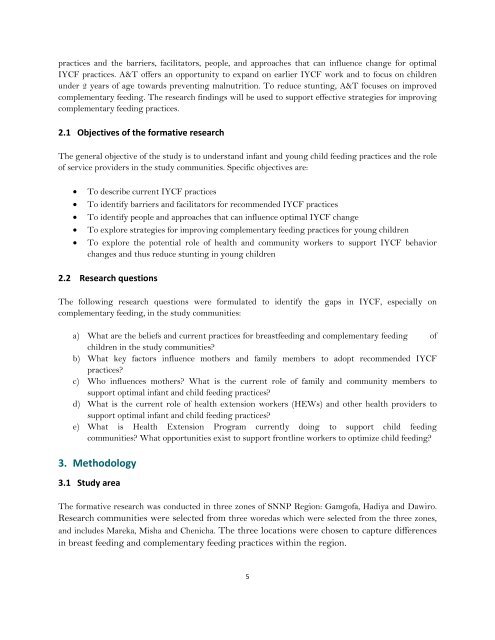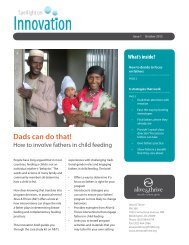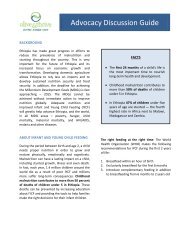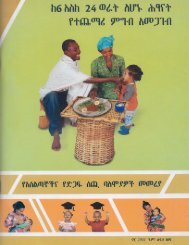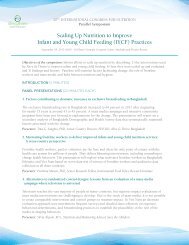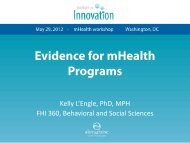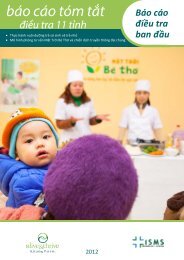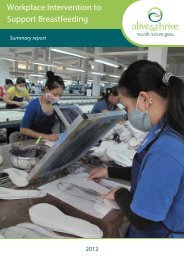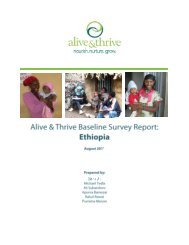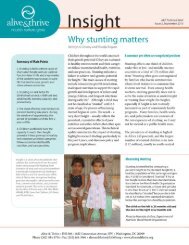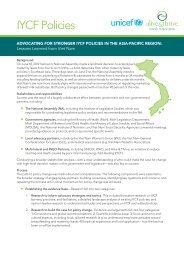IYCF Practices, Beliefs, and Influences in SNNP ... - Alive & Thrive
IYCF Practices, Beliefs, and Influences in SNNP ... - Alive & Thrive
IYCF Practices, Beliefs, and Influences in SNNP ... - Alive & Thrive
You also want an ePaper? Increase the reach of your titles
YUMPU automatically turns print PDFs into web optimized ePapers that Google loves.
practices <strong>and</strong> the barriers, facilitators, people, <strong>and</strong> approaches that can <strong>in</strong>fluence change for optimal<strong>IYCF</strong> practices. A&T offers an opportunity to exp<strong>and</strong> on earlier <strong>IYCF</strong> work <strong>and</strong> to focus on childrenunder 2 years of age towards prevent<strong>in</strong>g malnutrition. To reduce stunt<strong>in</strong>g, A&T focuses on improvedcomplementary feed<strong>in</strong>g. The research f<strong>in</strong>d<strong>in</strong>gs will be used to support effective strategies for improv<strong>in</strong>gcomplementary feed<strong>in</strong>g practices.2.1 Objectives of the formative researchThe general objective of the study is to underst<strong>and</strong> <strong>in</strong>fant <strong>and</strong> young child feed<strong>in</strong>g practices <strong>and</strong> the roleof service providers <strong>in</strong> the study communities. Specific objectives are:• To describe current <strong>IYCF</strong> practices• To identify barriers <strong>and</strong> facilitators for recommended <strong>IYCF</strong> practices• To identify people <strong>and</strong> approaches that can <strong>in</strong>fluence optimal <strong>IYCF</strong> change• To explore strategies for improv<strong>in</strong>g complementary feed<strong>in</strong>g practices for young children• To explore the potential role of health <strong>and</strong> community workers to support <strong>IYCF</strong> behaviorchanges <strong>and</strong> thus reduce stunt<strong>in</strong>g <strong>in</strong> young children2.2 Research questionsThe follow<strong>in</strong>g research questions were formulated to identify the gaps <strong>in</strong> <strong>IYCF</strong>, especially oncomplementary feed<strong>in</strong>g, <strong>in</strong> the study communities:a) What are the beliefs <strong>and</strong> current practices for breastfeed<strong>in</strong>g <strong>and</strong> complementary feed<strong>in</strong>g ofchildren <strong>in</strong> the study communities?b) What key factors <strong>in</strong>fluence mothers <strong>and</strong> family members to adopt recommended <strong>IYCF</strong>practices?c) Who <strong>in</strong>fluences mothers? What is the current role of family <strong>and</strong> community members tosupport optimal <strong>in</strong>fant <strong>and</strong> child feed<strong>in</strong>g practices?d) What is the current role of health extension workers (HEWs) <strong>and</strong> other health providers tosupport optimal <strong>in</strong>fant <strong>and</strong> child feed<strong>in</strong>g practices?e) What is Health Extension Program currently do<strong>in</strong>g to support child feed<strong>in</strong>gcommunities? What opportunities exist to support frontl<strong>in</strong>e workers to optimize child feed<strong>in</strong>g?3. Methodology3.1 Study areaThe formative research was conducted <strong>in</strong> three zones of <strong>SNNP</strong> Region: Gamgofa, Hadiya <strong>and</strong> Dawiro.Research communities were selected from three woredas which were selected from the three zones,<strong>and</strong> <strong>in</strong>cludes Mareka, Misha <strong>and</strong> Chenicha. The three locations were chosen to capture differences<strong>in</strong> breast feed<strong>in</strong>g <strong>and</strong> complementary feed<strong>in</strong>g practices with<strong>in</strong> the region.5


